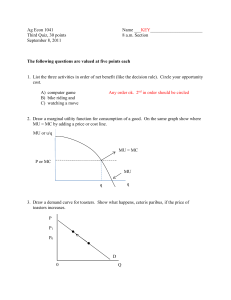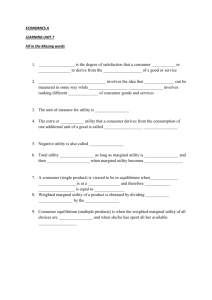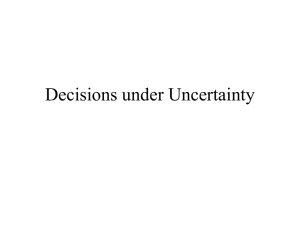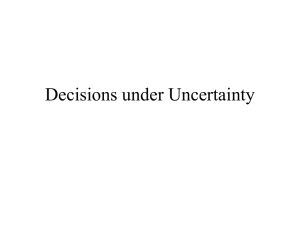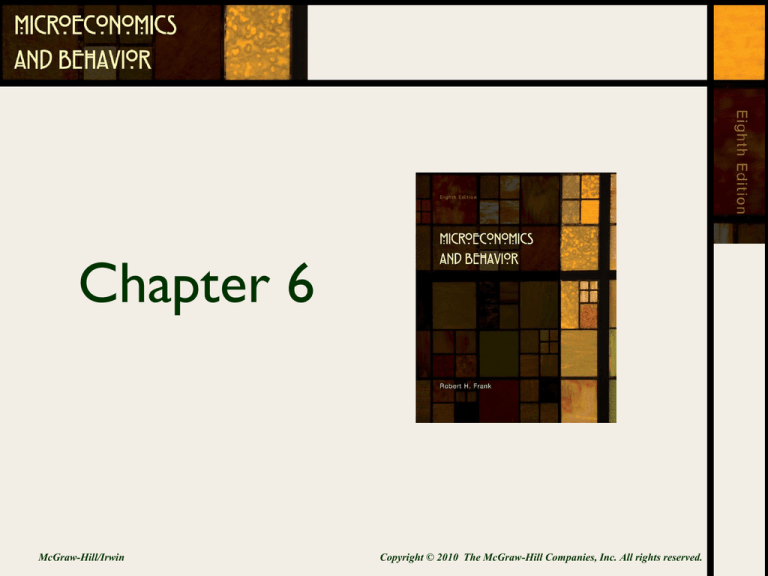
Chapter 6
McGraw-Hill/Irwin
Copyright © 2010 The McGraw-Hill Companies, Inc. All rights reserved.
The Economics of
Information and Choice
Under Uncertainty
6-2
Chapter Outline
• The Economics Of Information
• Choice Under Uncertainty
• Insuring Against Bad Outcomes
6-3
Signaling
•
•
•
Signaling: communication that conveys
information.
Two properties of signaling: between potential
adversaries:
1. Signals must be costly to fake
2. If some individuals use signals that convey favorable
information about themselves, others will be forced to
reveal information even when it is considerably less
favorable.
6-4
Costly-to-Fake Principle
• Costly-to-fake principle: for a signal to an
adversary to be credible, it must be costly to
fake.
• Economic applications:
– Product Quality Assurance
– Choosing a Trustworthy Employee
– Choosing a Hard-Working, Smart
Employee
6-5
The Full-disclosure Principle
• Full-disclosure principle: individuals must
disclose even unfavorable qualities about
themselves, lest their silence be taken to
mean that they have something even worse
to hide.
6-6
Applications of Full Disclosure Principle
• Product Warranties
– Producers know much more than consumers about how good their
products are.
• Regulating the Employment Interviewer
– Lack of evidence that something resides in a favored category will
often suggest that it belongs to a less favored one.
• The Lemons Principle
– Cars offered for sale, taken as a group, are simply of lower average
quality than cars not offered for sale.
• The Stigma of the Newcomer
6-7
Figure 6.1: The Information Implicit
in Silence
6-8
Probability And Expected Value
• Expected value: the sum of all possible
outcomes, weighted by its respective
probability of occurrence.
– In addition to the expected value of a gamble,
most people also consider how they feel about
each of its possible outcomes.
6-9
Probability And Expected Value
• People choose the alternative that has the
highest expected utility.
– Expected utility: the expected utility of a gamble
is the expected value of utility over all possible
outcomes.
• The expected values of the outcomes of a set
of alternatives need not have the same ranking
as the expected utilities of the alternatives.
6-10
Probability And Expected Value
• Diminishing marginal utility: for a utility
function defined on wealth, one in which the
marginal utility declines as wealth rises.
• Fair gamble: a gamble whose expected value
is zero.
6-11
Type of Risk Preferences
• Risk averse: preferences described by a utility
function with diminishing marginal utility of wealth.
• Risk seeking: preferences described by a utility
function with increasing marginal utility of wealth.
• Risk neutral: preferences described by a utility
function with constant marginal utility of wealth.
6-12
Figure 6.2: A Concave Utility Function
6-13
Figure 6.3: A Risk-Averse Person Will
Always Refuse a Fair Gamble
6-14
Figure 6.4:The Utility Function of a
Risk-Seeking Person is Convex in Total Wealth
6-15
Figure 6.5: Risk Neutrality
6-16
Figure 6.6: The Value of Reducing Uncertainty
6-17
Risk Pooling
• Law of large numbers: a statistical law that
says that if an event happens independently
with probability p in each of N instances, the
proportion of cases in which the event
occurs approaches p as N grows larger.
– Makes it possible for people to reduce their risk
exposure through pooling arrangements.
6-18
Adverse Selection and Moral Hazard
• Adverse selection: process by which the
less desirable potential trading partners
volunteer to exchange.
• Moral hazard: incentives that lead people
to file fraudulent claims or to be negligent in
their care of goods insured against theft or
damage.
6-19
Figure 6.9: The Reservation Price
for Insurance
6-20
Figure A6.1: A Hypothetical Uniform
Wage Distribution
6-21
Figure A6.2: The Expected Value of an
Offer that is Greater than $150
6-22
Figure A6.3: The Acceptance Wage
6-23
Figure A6.4: A Hypothetical
Price Distribution
6-24
Figure A6.5: The Acceptance Price as
a Function of the Cost of Search
6-25
Figure A6.6: An Unbiased Estimate
with a Uniform Distribution
6-26
Figure A6.7: The Expected Value
of The Highest Estimate N = 1,2,3 & 4
6-27






